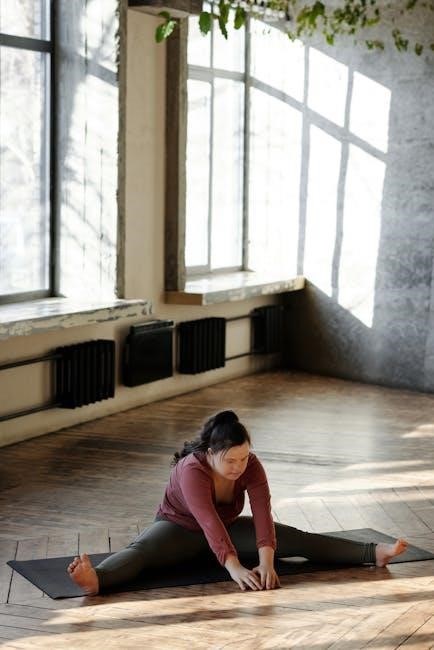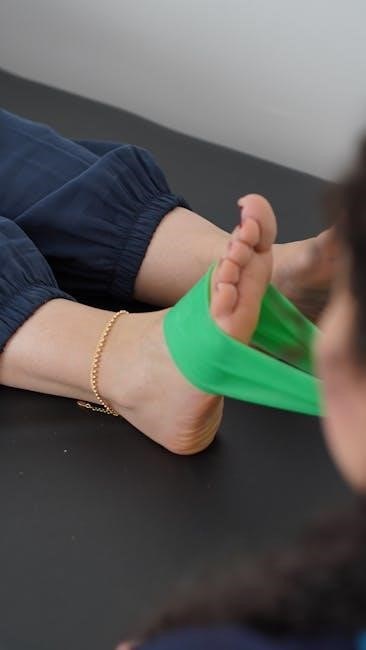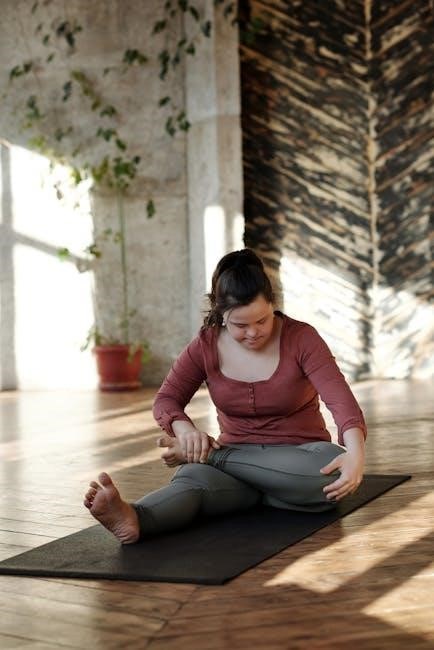Iliotibial Band Syndrome (ITBS) is a common condition causing pain on the outside of the knee, often due to repetitive friction or overuse. It primarily affects athletes and runners, impacting the iliotibial band, a thick tissue connecting hip muscles to the shinbone. Proper stretching and strengthening exercises are essential for managing symptoms and preventing recurrence.

1.1 Definition and Overview
Iliotibial Band Syndrome (ITBS) is a common condition characterized by pain and inflammation on the outside of the knee. It occurs when the iliotibial band, a thick fibrous tissue running from the hip to the shinbone, becomes irritated or inflamed. This typically results from repetitive friction or overuse, often seen in runners, cyclists, and individuals engaging in repetitive knee-bending activities. ITBS is not an inflammatory condition but rather a friction syndrome caused by the IT band rubbing against the lateral femoral condyle. Symptoms include sharp pain, tenderness, and swelling on the outside of the knee, which may worsen during exercise. Proper management involves stretching, strengthening, and addressing underlying causes like poor form or muscle imbalances. Early intervention is crucial to prevent chronic pain and restore full mobility.

1.2 Importance of Stretching in ITBS Management
Stretching plays a crucial role in managing Iliotibial Band Syndrome (ITBS) by reducing tension and improving flexibility in the IT band; Regular stretching helps alleviate pain and inflammation, preventing further irritation. It targets the outer thigh and hip muscles, which are often tight in individuals with ITBS. Stretching exercises, such as standing, seated, and supine stretches, can be performed daily to maintain mobility. Holding stretches for 15-20 seconds and repeating them 2-3 times ensures maximum benefit. Additionally, dynamic stretching before exercise can reduce the risk of flare-ups. Incorporating tools like straps or bands enhances the effectiveness of stretches. Consistent stretching not only aids in recovery but also helps prevent recurrence, making it a cornerstone of ITBS management. By prioritizing stretching, individuals can restore normal movement and reduce discomfort associated with ITBS.
Causes and Risk Factors of ITBS
ITBS is primarily caused by repetitive friction of the iliotibial band over the lateral femoral condyle. Overuse, weak glutes, tight hip flexors, and poor exercise form contribute to its development.
2.1 Anatomy of the Iliotibial Band

The iliotibial (IT) band is a thick, fibrous structure running along the outer thigh, from the iliac crest (pelvic bone) to the tibia (shinbone). It is not a muscle but a tendon-like tissue connecting the gluteus maximus and tensor fasciae latae muscles to the knee. The IT band plays a crucial role in stabilizing the knee during movements like walking, running, and cycling. Its tightness or friction over the lateral femoral condyle can lead to inflammation and pain, commonly associated with ITBS. Understanding its anatomy is essential for effective stretching and strengthening exercises to manage symptoms and prevent recurrence. Proper care of the IT band through targeted stretches and exercises can significantly improve mobility and reduce discomfort in individuals prone to this condition.
2.2 Repetitive Motion and Overuse
Repetitive motion and overuse are primary contributors to ITBS, particularly in activities like running, cycling, or hiking. The IT band repeatedly rubs over the lateral femoral condyle, causing friction and inflammation. Over time, this friction leads to pain and swelling on the outside of the knee. Athletes or individuals engaging in repetitive knee-bending activities are at higher risk. Prolonged or intense workouts without adequate rest exacerbate the condition. Addressing overuse involves modifying training routines, incorporating rest days, and engaging in cross-training to reduce stress on the IT band. Proper warm-up and cool-down exercises, along with targeted stretches, can help mitigate the risk of ITBS. Recognizing the signs of overuse early is crucial to prevent progression and ensure effective management of symptoms.
2.3 Weakness in Glutes and Hip Flexors
Weakness in the glutes and hip flexors is a significant contributor to ITBS. The gluteal muscles play a crucial role in stabilizing the hip and controlling leg movement during activities like running or cycling. When these muscles are weak, it can lead to poor movement patterns, such as excessive hip adduction and internal rotation, which increase stress on the IT band. Similarly, weak hip flexors can disrupt proper pelvic alignment, further exacerbating IT band friction. Strengthening exercises targeting the glutes, particularly the gluteus medius and maximus, are essential to restore hip stability and reduce the risk of ITBS. Addressing hip flexor weakness also helps maintain proper biomechanics, preventing overuse and repetitive strain on the IT band. Combining strengthening with stretching can effectively manage and prevent ITBS symptoms.
2.4 Poor Form During Exercise
Poor form during exercise is a key contributor to ITBS, as it can lead to improper biomechanics and increased stress on the IT band. Activities like running, cycling, or hiking with inadequate posture or technique can cause repetitive strain. For instance, overstriding while running or leaning too far forward on a bike can misalign the hips and knees, leading to excessive friction on the IT band. Additionally, weak core muscles or improper weight distribution during exercises like squats or lunges can exacerbate the issue. Over time, these inefficiencies can result in inflammation and pain along the outside of the knee. Addressing poor form through proper training and technique adjustments is crucial to preventing ITBS and reducing its symptoms. Strengthening exercises and stretching can also help correct imbalances caused by poor form.
Symptoms and Diagnosis of ITBS
ITBS typically causes sharp pain or swelling on the outside of the knee, especially during activities like running or cycling. Pain may worsen with repetitive motion. A proper diagnosis involves physical exams, patient history, and sometimes imaging to rule out other knee issues. Self-assessment techniques, like palpation or specific stretches, can help identify ITBS symptoms early. If pain persists or worsens, consulting a healthcare professional is essential for an accurate diagnosis and effective treatment plan.
3.1 Common Symptoms and Pain Locations
Common symptoms of ITBS include sharp or burning pain on the outside of the knee, swelling, and tenderness. Pain often worsens during activities like running, cycling, or climbing stairs. The iliotibial band, running from the hip to the shinbone, can cause discomfort when it rubs against the thigh bone. Pain typically occurs on the lateral (outer) aspect of the knee and may radiate up the thigh or down the leg. Swelling or redness near the knee joint may also appear. Symptoms often intensify with repetitive motion or prolonged activity. Early identification of these symptoms is crucial for effective management and prevention of further complications. If pain persists or worsens, seeking professional diagnosis is recommended to rule out other knee-related issues.
3.2 When to Seek Professional Diagnosis
If symptoms of ITBS persist or worsen despite rest and stretching, it is crucial to seek professional diagnosis. A healthcare provider can evaluate pain severity, swelling, and limited mobility. They may perform physical exams or imaging tests to rule out other knee conditions like meniscus tears or ligament injuries. Persistent pain on the outside of the knee, especially during activities, warrants medical attention. If home remedies fail to alleviate symptoms within a few weeks, consulting a specialist is recommended. Early intervention can prevent further complications and ensure proper treatment. A professional diagnosis will confirm ITBS and guide appropriate rehabilitation strategies, ensuring effective recovery and return to normal activities.
3.3 Self-Assessment Techniques
Self-assessment techniques for ITBS involve identifying pain locations and triggers. Start by palpating the outside of the thigh and knee to detect tenderness. Perform stretches like the standing IT band stretch to check for discomfort. Pay attention to pain during activities such as running or cycling; If pain persists or worsens, it may indicate ITBS. Use a journal to track symptoms and activities. Compare findings with common ITBS symptoms, such as lateral knee pain during exercise. If self-assessment confirms ITBS, begin stretching exercises like the seated or supine IT band stretch. However, if symptoms are severe or unclear, consult a professional for an accurate diagnosis and personalized treatment plan. Early self-assessment can guide appropriate management and prevent progression of the condition.
Prevention Strategies
Preventing ITBS involves proper training techniques, wearing supportive footwear, and using orthotics. Incorporating cross-training and gradual intensity increases can reduce overuse risks and promote long-term joint health effectively.
4.1 Proper Training and Exercise Techniques
Proper training and exercise techniques are crucial in preventing ITBS. This includes avoiding repetitive overuse and ensuring correct movement patterns during activities like running or cycling. Strengthening exercises for the hips and glutes can help stabilize the pelvis, reducing strain on the IT band. Incorporating dynamic stretches before workouts and static stretches afterward can improve flexibility and reduce tightness. Additionally, gradually increasing training intensity and distance helps the body adapt without overloading the IT band. Using proper footwear and orthotics can also align the body correctly, minimizing friction on the IT band. Regularly incorporating cross-training activities, such as swimming or cycling, can reduce repetitive stress on the knees and hips. By focusing on balanced training and proper form, individuals can significantly lower their risk of developing ITBS and maintain optimal joint health.
4.2 The Role of Footwear and Orthotics

Proper footwear and orthotics play a significant role in preventing and managing ITBS. Wearing shoes with adequate support and cushioning can help reduce stress on the IT band by promoting proper alignment of the feet and legs. Orthotics, such as custom insoles, can correct issues like overpronation or supination, which may contribute to ITBS. By addressing biomechanical imbalances, orthotics can reduce the friction and repetitive stress on the IT band during activities like running or walking. Additionally, footwear with good arch support and shock absorption can minimize the impact on the knees and hips, further reducing the risk of ITBS. Incorporating the right footwear and orthotics into your routine can help prevent ITBS recurrence and support overall lower limb health.
4.3 Incorporating Cross-Training
Incorporating cross-training into your routine is a highly effective strategy for preventing and managing ITBS. Cross-training involves engaging in alternative activities that reduce repetitive stress on the IT band while maintaining fitness levels. Activities like swimming, cycling, or elliptical training are excellent options, as they minimize impact on the knees and hips. These exercises help strengthen surrounding muscles without overloading the IT band, promoting overall lower limb stability. Additionally, cross-training can improve cardiovascular fitness and muscular endurance, making it a well-rounded approach to injury prevention. By varying your workout routine, you can avoid the repetitive motions that often lead to ITBS. This approach is particularly beneficial for athletes and runners, allowing them to recover while still maintaining their fitness goals. Regular cross-training can significantly reduce the risk of ITBS recurrence and enhance long-term athletic performance;
Stretching Exercises for ITBS
Effective ITBS stretching includes standing, seated, and supine stretches, often using straps for deeper relief. Perform 3 sets of 15-20 seconds holds daily to alleviate pain and improve mobility;

5.1 Standing Iliotibial Band Stretch
The standing iliotibial band stretch is a simple yet effective exercise to relieve tension. Stand with your feet shoulder-width apart and cross the affected leg behind the unaffected leg. Bend the knee of the unaffected leg slightly and lean toward the opposite side until a stretch is felt along the outside of the thigh. Hold for 15-20 seconds and repeat 3 sets daily. Ensure your back remains straight and avoid leaning forward. This stretch targets the IT band, reducing friction and pain. Perform on both legs to maintain balance and prevent imbalance. For enhanced stretch, use an exercise band tied above the knees to apply gentle resistance. Consistency is key to managing ITBS symptoms effectively.
5.2 Seated Iliotibial Band Stretch
The seated iliotibial band stretch is an excellent exercise for targeting the IT band while in a comfortable position. Sit on the floor with your legs extended straight in front of you. Cross the affected leg over the unaffected leg, placing the ankle on the opposite knee. Gently press the knee of the crossed leg toward your chest until a stretch is felt along the outside of the thigh. Hold for 15-20 seconds and repeat 3 sets daily. This stretch helps reduce tension and friction in the IT band, alleviating pain and improving mobility; Perform on both legs to ensure balanced flexibility. For enhanced effectiveness, maintain proper posture and avoid bouncing during the stretch. Consistency with this exercise is crucial for managing ITBS symptoms and preventing recurrence.

5.3 Supine Iliotibial Band Stretch with Strap
The supine iliotibial band stretch with a strap is an effective way to target the IT band while lying down. Begin by lying on your back with your legs straight. Loop a stretch strap or towel around the ball of one foot, holding both ends of the strap in your hands. Gently pull the strap upward, lifting your leg toward the ceiling until a stretch is felt along the outside of the thigh. Hold for 15-20 seconds, then slowly lower your leg. Repeat 3 sets on each leg. This stretch is particularly useful for individuals who find standing stretches challenging. It helps reduce tension in the IT band and improves flexibility. Perform this exercise daily to alleviate ITBS symptoms and enhance overall hip mobility. Consistency is key for long-term relief and prevention of recurrence.
5.4 Side-Lying Iliotibial Band Stretch
The side-lying iliotibial band stretch targets the IT band while lying on one side. Start by lying on your side with your legs straight and feet touching. Cross the leg you want to stretch over the other, placing the ankle on the opposite knee. Loop a stretch strap or towel around the ankle of the crossed leg and gently pull upward. You should feel a stretch along the outside of the thigh. Hold for 15-20 seconds, then release. Perform 3 sets on each leg. This stretch is ideal for improving flexibility and reducing tension in the IT band. It can be done daily to help manage ITBS symptoms and prevent recurrence. Proper form is essential to ensure the stretch targets the correct area and avoids discomfort in the knee or hip.
5.5 Dynamic Stretching for ITBS
Dynamic stretching is a highly effective way to improve flexibility and reduce stiffness in the iliotibial band. Unlike static stretches, dynamic movements involve continuous motion, mimicking real-life activities. Start with leg swings: stand sideways near a wall for support and swing one leg forward and backward, then switch sides. High knees and butt kicks are also excellent, as they engage the hip flexors and glutes, which are often tight in ITBS sufferers. Side lunges are another great option, stretching the outer thigh while promoting balance. Perform each exercise for 1-2 minutes, focusing on smooth, controlled movements. Dynamic stretching should be done before running or cycling to warm up the muscles and reduce the risk of irritation. Incorporating these exercises into your routine can significantly improve IT band mobility and overall athletic performance.
5.6 Using a Foam Roller for IT Band Release
Using a foam roller for IT band release is an excellent way to alleviate tension and reduce discomfort associated with ITBS. Start by positioning the foam roller just above your knee on the outside of your thigh. Slowly roll upward toward your hip, applying moderate pressure. Pause for a few seconds on any tender spots to allow the tissue to release. Repeat this process for 2-3 sets, spending about 30 seconds on each leg. This technique helps break down adhesions in the IT band, improving circulation and flexibility. For enhanced relief, incorporate this exercise into your daily routine, especially after workouts or long periods of sitting. Consistent use of a foam roller can significantly reduce IT band tightness and prevent future flare-ups of ITBS.

Strengthening Exercises
Strengthening exercises targeting the hips, glutes, and core are crucial for ITBS management. They improve muscle balance, reduce tension on the IT band, and prevent recurrence of symptoms.
6.1 Hip and Glute Strengthening Exercises
Hip and glute strengthening exercises are essential for addressing ITBS, as weak hip muscles often contribute to the condition. Clamshell exercises, side-lying leg lifts, and glute bridges are effective for targeting the gluteus medius and minimus. These exercises help improve hip stability and reduce excessive movement that can irritate the IT band. Strengthening the glutes also enhances overall lower limb alignment during activities like running or cycling. Perform 2-3 sets of 10-15 repetitions for each exercise, focusing on controlled movements. Incorporating these exercises into a daily routine can significantly reduce ITBS symptoms and prevent future flare-ups by promoting proper muscle balance and joint mechanics.
6.2 Core Strengthening to Support Hip Stability
Core strengthening is crucial for hip stability, as a weak core can lead to poor posture and improper movement patterns that exacerbate ITBS. Exercises like planks, bird dogs, and side planks target the abdominal muscles and lower back, improving overall stability. Strengthening the transverse abdominis muscle, in particular, helps maintain pelvic alignment and reduces unnecessary hip movement during activities. Incorporate exercises such as Superman, pelvic tilts, and single-leg balances to enhance core endurance and hip stability. Perform these exercises 2-3 times weekly, focusing on controlled movements and proper form. A strong core provides a foundation for efficient hip and glute function, reducing the risk of ITBS recurrence and improving athletic performance. Consistency in core training is key to long-term hip health and injury prevention.

Rehabilitation and Recovery
Rehabilitation for ITBS focuses on physical therapy, stretching, and strengthening exercises to restore hip and knee function. Consistency in exercises like standing stretches and core work aids recovery and prevents recurrence.
7.1 The Role of Physical Therapy
Physical therapy plays a crucial role in managing ITBS by addressing pain, improving mobility, and strengthening surrounding muscles. A personalized treatment plan often includes manual therapy, such as massage or joint mobilization, to reduce tension in the IT band. Therapists also guide patients through targeted stretching and strengthening exercises, like standing ITB stretches and hip-strengthening movements, to restore proper biomechanics. Education on proper posture, gait, and exercise techniques is provided to prevent recurrence. Progress is monitored to ensure safe and effective recovery, with adjustments made as needed. Physical therapy not only alleviates symptoms but also enhances overall lower extremity function, making it a cornerstone of ITBS rehabilitation.
7.2 Progressive Loading and Exercise
Progressive loading and exercise are essential for rehabilitation and recovery from ITBS. This approach involves gradually increasing the intensity of exercises to strengthen the muscles around the knee and hip, improving joint stability. Activities like step-ups, balance work, and controlled movements help restore proper biomechanics without overloading the IT band. Strengthening the glutes and hip flexors is particularly important, as weakness in these areas often contributes to ITBS. Exercises should be performed with proper form to avoid aggravating the condition. Over time, progressive loading helps rebuild tissue resilience, reducing the risk of recurrence. A structured program ensures a safe transition back to normal activities, promoting long-term recovery and preventing future episodes of ITBS. This method is widely recommended in rehabilitation protocols for its effectiveness in restoring function and reducing pain.

When to See a Doctor
Consult a healthcare professional if experiencing persistent pain, limited mobility, or worsening symptoms despite self-care measures. A doctor can provide a proper diagnosis and tailored treatment plan.
8.1 Persistent Pain and Limited Mobility
Persistent pain and limited mobility are key indicators that ITBS requires medical attention. If pain persists despite rest, stretching, and strengthening exercises, consult a healthcare professional. Sharp pain on the outside of the knee, swelling, or difficulty performing daily activities are concerning signs. A doctor can rule out other conditions like tendonitis or arthritis. They may recommend imaging or physical therapy to address underlying issues. Ignoring persistent symptoms can lead to chronic pain or further injury. Early intervention is crucial for effective recovery and preventing long-term mobility issues. A tailored treatment plan, including physical therapy or orthotics, can help restore function and alleviate discomfort. Don’t delay seeking professional help if symptoms worsen or persist, as proper care is essential for full recovery.
Iliotibial Band Syndrome is a common issue, especially in athletes. Proper stretching and strengthening exercises are key to effectively managing symptoms and preventing recurrence. Consistency is essential for recovery.
9.1 Summary of Key Points
Iliotibial Band Syndrome (ITBS) is a common condition causing pain on the outside of the knee, often due to repetitive friction or overuse. It primarily affects athletes and runners, impacting the iliotibial band, a thick tissue connecting hip muscles to the shinbone. Proper stretching and strengthening exercises are essential for managing symptoms and preventing recurrence. Key strategies include standing, seated, and supine stretches, as well as dynamic stretching and foam roller use. Strengthening hip and glute muscles is also crucial. Prevention involves proper footwear, orthotics, and cross-training. If pain persists, seeking professional diagnosis and physical therapy is recommended. Consistency in exercises and addressing underlying causes are vital for effective recovery and long-term management of ITBS.

Leave a Reply
You must be logged in to post a comment.